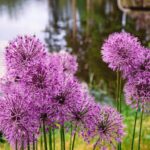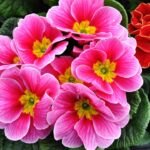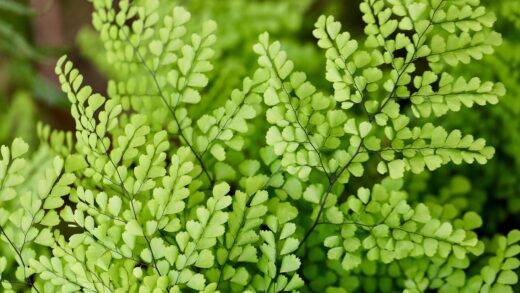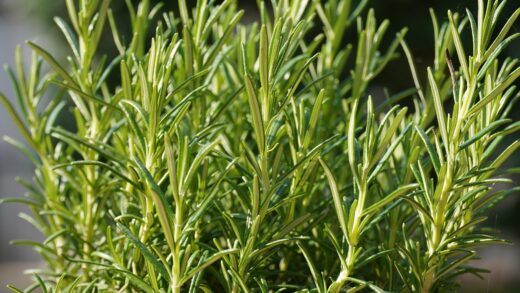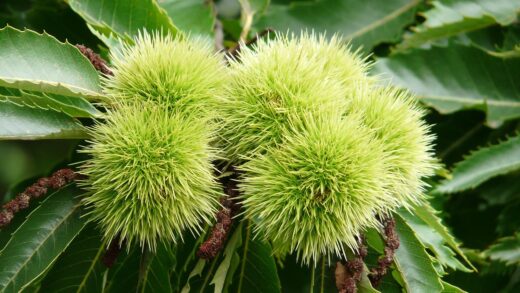Diseases and pests of the Delta maidenhair fern

Despite its delicate appearance, the Delta maidenhair fern is a relatively resilient plant, and when provided with its ideal growing conditions, it can remain free of most common diseases and pests. The majority of problems that arise are directly linked to environmental stress, such as improper watering, low humidity, or poor air circulation. Therefore, the most effective strategy for managing diseases and pests is prevention, which begins with a commitment to maintaining a consistently healthy and stable environment for the fern. A thriving plant is naturally more capable of warding off potential threats.
When issues do occur, they are often related to the high-humidity environment that the fern requires. While essential for the plant’s health, these moist conditions can also create a favorable breeding ground for certain fungal diseases and pests that thrive in dampness. Problems like root rot are almost exclusively caused by overwatering or poor drainage, which allows the soil to become waterlogged and suffocates the roots. Recognizing the early signs of such issues is crucial for successful intervention and saving the plant.
Common household pests can occasionally infest a Delta maidenhair fern, although they are less common than on many other houseplants. Pests such as aphids, mealybugs, and scale insects may be attracted to the tender new growth. A vigilant eye is the best defense, as catching an infestation in its early stages makes it significantly easier to control. Regular inspection of the undersides of fronds and the points where stems meet the soil can help in the early detection of these unwelcome visitors.
Ultimately, a proactive and observant approach to plant care is the best defense against diseases and pests. By focusing on creating an optimal growing environment—high humidity, consistent moisture, bright indirect light, and good air flow—you significantly reduce the likelihood of problems. Should an issue arise, prompt identification and the use of the gentlest effective treatment methods will help to restore the health of your fern while minimizing stress on the plant and the surrounding environment.
Fungal diseases and root rot
The most significant disease threat to the Delta maidenhair fern is root rot, a condition caused by various soil-borne fungi. This disease is not something the plant ‘catches’ in the traditional sense; rather, it is a direct consequence of an unfavorable growing environment. The primary cause of root rot is soil that remains waterlogged for extended periods due to overwatering, a pot with inadequate drainage, or a heavy, compacted potting mix. These conditions create an anaerobic environment, depriving the roots of oxygen and allowing opportunistic fungi like Pythium and Phytophthora to thrive and attack the weakened root system.
More articles on this topic
The initial symptoms of root rot can be misleading, as they often appear as signs of underwatering. The plant may wilt, and its fronds may turn yellow and begin to die back. This is because the rotting roots are no longer able to absorb water and nutrients to supply the foliage. To confirm root rot, you must inspect the root ball. Healthy fern roots are typically thin, wiry, and light in color. In contrast, rotting roots will be dark brown or black, mushy to the touch, and may have a foul, decaying odor.
Treating root rot requires immediate and decisive action, though success is not guaranteed, especially in advanced cases. Carefully remove the fern from its pot and wash away as much of the old soil as possible to fully expose the roots. Using a pair of sterilized scissors or pruning shears, trim away all of the dark, mushy, and dead roots, leaving only the healthy, firm ones. If a significant portion of the root system has been removed, you may also need to prune back a corresponding amount of the foliage to reduce the demand on the remaining roots.
After trimming the roots, repot the fern in a clean pot with fresh, sterile, well-draining potting mix. The new pot should be appropriately sized for the reduced root ball. Following the procedure, water the plant sparingly and place it in a location with high humidity and bright, indirect light to aid its recovery. Withhold fertilizer until the plant shows clear signs of new growth, indicating that the root system has begun to recover and re-establish itself.
Common houseplant pests
While the Delta maidenhair fern is not a primary target for most pests, it can occasionally fall prey to common indoor insects, especially when the plant is stressed. Aphids are one potential culprit. These are small, pear-shaped insects, often green or black, that use their piercing mouthparts to suck sap from the tender new fronds and stems. They tend to cluster on new growth and can cause distortion, yellowing, and a sticky residue known as honeydew, which can in turn lead to sooty mold.
More articles on this topic
Mealybugs are another pest that may appear. These small, oval insects are covered in a white, waxy, cotton-like substance that protects them from predators and pesticides. They hide in the crevices where the fronds join the stems and at the base of the plant, sucking sap and weakening the fern over time. Like aphids, they also excrete honeydew. A small infestation can be managed by dabbing each mealybug with a cotton swab dipped in rubbing alcohol.
Scale insects are more difficult to detect. These pests appear as small, immobile, brown or tan bumps attached to the stems and the undersides of the fronds. They have a hard, protective shell that shields them from many treatments. They feed on the plant’s sap, and a heavy infestation can lead to yellowing leaves and reduced plant vigor. They can be scraped off individually with a fingernail or a small tool, but this can be a tedious process on a delicate fern.
Spider mites, though less common on ferns due to the high humidity they require, can become a problem in drier conditions. These tiny arachnids are difficult to see with the naked eye, but their presence is often indicated by fine webbing on the plant and a stippled, faded appearance on the fronds. Increasing humidity is a key step in controlling spider mites, as they thrive in dry air.
Integrated pest management strategies
An integrated pest management (IPM) approach is the most effective and environmentally responsible way to handle pests on a Delta maidenhair fern. IPM prioritizes prevention and uses the least toxic methods first. The foundation of IPM is maintaining a healthy plant, as pests are more likely to attack a plant that is already weakened by poor growing conditions. Regularly inspect your fern, paying close attention to the undersides of the leaves and the base of the plant, to catch any infestations early.
If pests are detected, the first line of defense should be physical removal. For pests like aphids and mealybugs, a strong spray of water from a showerhead or spray bottle can be effective at dislodging them. Individual mealybugs or scale insects can be removed manually using a cotton swab soaked in isopropyl alcohol. This direct approach can often manage a minor infestation without the need for chemical treatments.
If a pest problem persists, the next step is to use horticultural oils or insecticidal soaps. These products are generally considered safer than synthetic chemical pesticides. They work by suffocating the pests rather than poisoning them. It is crucial to test any spray on a small, inconspicuous part of the fern first and wait 24 hours to ensure it does not cause any damage to the delicate fronds. Always follow the product’s label instructions carefully and ensure complete coverage of the plant, including the undersides of the leaves.
The use of systemic or broad-spectrum chemical pesticides should be considered a last resort, as they can be harsh on the sensitive maidenhair fern and can harm beneficial insects. If they must be used, choose a product specifically labeled as safe for use on ferns. Preventing infestations in the first place is always the better strategy. This includes inspecting any new plants thoroughly before bringing them into your home to avoid introducing pests to your existing collection.
Preventing future outbreaks
The most effective way to deal with diseases and pests is to prevent them from occurring in the first place. This preventative care starts with providing the fern with its optimal growing conditions. A healthy, robust plant has a much stronger natural defense system against potential invaders. Ensure your fern has consistently moist soil, high humidity, bright indirect light, and a well-draining potting mix. Avoiding environmental stress is the cornerstone of prevention.
Good air circulation is another critical factor in preventing fungal diseases. While the maidenhair fern needs high humidity, stagnant, damp air can encourage the growth of mold and fungi. Placing the fern in a room with gentle air movement, or using a small fan on a low setting in the vicinity (without creating a direct draft on the plant), can help to keep the foliage dry and discourage fungal spores from settling and germinating.
Proper plant hygiene plays an important role in prevention. Regularly remove any dead, yellowing, or decaying fronds from the plant and the soil surface. This organic debris can harbor fungal spores and provide a hiding place for pests. When pruning, always use clean, sterilized tools to avoid transferring pathogens from one plant to another. Keeping the area around your plants clean and free of debris reduces the overall risk of problems.
Finally, practicing quarantine for new plants is a crucial preventative measure. Whenever you bring a new plant into your home, keep it isolated from your existing collection for at least a few weeks. During this quarantine period, inspect the new plant regularly for any signs of pests or diseases. This simple practice can prevent the introduction of a problem that could quickly spread to your other, healthy houseplants, including your delicate Delta maidenhair fern.
Recognizing symptoms of distress
Being an observant plant owner is key to catching problems early. The Delta maidenhair fern will show distinct symptoms when it is suffering from disease or a pest infestation. Beyond the common signs of cultural issues, look for specific clues. For instance, if you notice a sticky substance on the fronds or the surface below the plant, this is likely honeydew, a clear indicator of sap-sucking pests like aphids or mealybugs. This often precedes the growth of black sooty mold on the honeydew.
Distorted or stunted new growth can also be a sign of a pest problem. When pests feed on the tender, developing fronds, they can cause them to unfurl in a misshapen or discolored way. If new growth appears damaged before it has even fully opened, carefully inspect the fiddleheads for tiny insects clustered within the unfurling frond. This is a common hiding place for aphids.
When inspecting for pests, look not only for the insects themselves but also for the evidence they leave behind. Fine webbing between the stems and fronds is a tell-tale sign of spider mites. White, cottony masses in leaf axils indicate mealybugs. Small, brown, immobile bumps on the stems are characteristic of scale insects. Seeing these signs, even if you cannot see the pest itself, warrants a closer investigation and prompt treatment.
In the case of root rot, the primary symptoms above the soil line—wilting and yellowing leaves—can mimic other problems. The definitive sign is found below the soil. If your fern is wilting despite the soil being moist, this is a major red flag for root rot. The combination of wilting foliage and perpetually wet soil is the strongest indicator that the root system is compromised and needs to be inspected immediately.














